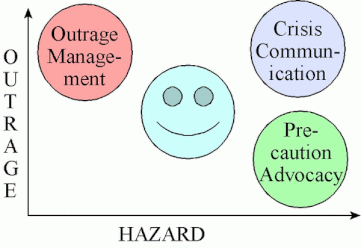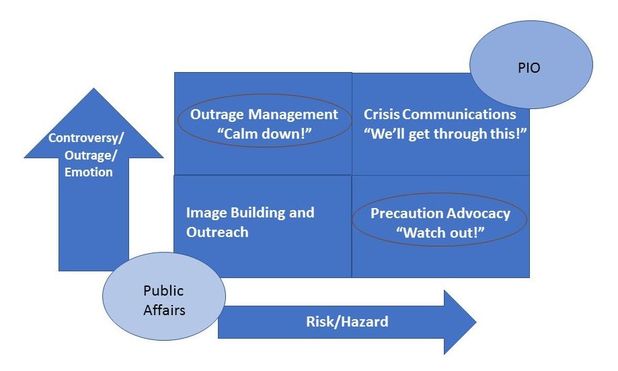|
About the time I finally became a Type I Public Information Officer, I became frustrated with the inability to advance my knowledge and skills beyond the standard courses. After maxing out on NWCG and FEMA classes and then teaching everything I could, there was no set avenue for further learning. Local colleges offered Communications courses but there was nothing in those classes that would get at what I wanted, assuming I could even describe what I wanted. It all led me to the obvious conclusion that there is a training and information deficit for advanced PIOs and Public Affairs Officers in government service. This will be the first in a series of posts where I talk about what I have found out there and I hope it will engender discussion and recommendations from others. This is certainly not to be considered the final word--it is merely what I found to be useful information. In 2006 I was glancing over an article about surviving disasters when I came across a paragraph devoted to Peter Sandman, who was described as a "Risk Communications Specialist." That title intrigued me and I went to his website, which was a revelation. There is a lot of good stuff there and I still find myself going back frequently because he adds clarity to my thoughts and provides the words and structure necessary for further thought. It took awhile to sort it all through my experiences and co-opt what I felt was important. Now, Sandman may not have the best rep out there. As far as I can tell, he will advise anyone and he has worked with some reprehensible corporate characters. In our correspondence, he admitted to chasing the buck from whatever source it came from. Also, some of the things he says I disagree with. So, this is not a full-throttled endorsement of every word on that site. However, I think for PIOs, he is well worth reading and again, he was the first one I found that helped me solidify my thinking. If you don't like reading, he has a number of videos on his site that are also worth your time. There are three major things I take away from Sandman: his risk = hazard + outrage construct, the idea that in crisis situations you have to embrace the uncertainty, and the related belief that "speaking in one voice" may not be the best course. I'll address the first one here and the other two in later posts. This is the classic illustration of Sandman's risk = hazard + outrage from his website: Here's how Sandman describes his approach: When hazard is high and outrage is low, the task is “precaution advocacy” – alerting insufficiently upset people to serious risks. “Watch out!” Now, here's the beautiful and perfectly proportioned PowerPoint version I created: Adding controversy and emotion to Sandman's outrage helps us understand our world a bit better. I think adding risk also makes things clearer.
When C/O/E is low and R/H is low, you're doing things that feel good and may build your reputation among a select but small group of people. Think of staff-led hikes or outreaching to kids. It's the most basic level of public affairs and frankly, not many people care. Getting news coverage is tough because you are essentially doing your job and there is no controversy. PIOs may do a little of this, like if an incident has gone well and tours of camp are offered to the community. Or taking cookies and brownies from the local Girl Scout troop. Yay us! When C/O/E is low and R/H is high, the challenge is how to prod people to act on a threat they don't think is that important. The classic example is defensible space. "Well, my daddy built this place and we've never had a fire, so no need for us to do anything." According to Sandman, the needed persuasive effort takes a suite of skills and techniques that are different from the parts of the chart that are high C/O/E and his thinking makes a lot of sense to me. Both the PAO and the PIO may dabble in this square, but it is not the primary concern of either, though Prevention Officers live here on most days When C/O/E is high and R/H is low is where PAOs spend most of their time. Similar to the earlier defensible space example, the classic one here is prescribed fire. There's prep work and resources and a good window with everything looking good and safe, but the neighbors are wary. However, most of the time, PAOs spend their efforts on stuff like resource management plans and project plans. These create controversy even if the agency believes the analysis is sound. If the opposition is due to a lack of information and the opposed are open to considering that information, it's not too difficult. However, controversy is often stoked by folks with an ax to grind politically, philosophically, or maybe they just don't like you and your agency. It will be difficult to change their minds. You make some effort, but you mostly march forward carrying the organizational torch. PIOs may be exposed to this, but one of the first PIO skills to develop is how to deflect THAT question to the agency administrator or PAO. When C/O/E is high and R/H is high, something bad is happening. A crisis that involves everyone and demands response. Fire on the hill, water over the dam. This is the realm of the PIO. I use this slide with both PAOs and PIOs. It is also the best way I have found to explain to managers the differences between the two. PIOs are not PAOs with yellow shirts. They may be the same people and use many of the same tools, but the PAO allegiance is to the long-term reputation of the organization and the PIO allegiance is to those affected by the incident. That creates a constant tension between PAOs and PIOs because of those differing responsibilities and both groups as well as management and and the IC need to understand that and watch for any escalation. If you are a PIO, recognize the needs of the PAO and understand the incident is putting additional stress on them. If you are a PAO recognize that your instincts and goals may conflict with that of the incident and do your best to manage that conflict knowing you will have all of the time after the incident to make a difference. _____ Jim Copyright © Jim Whittington, 2018, All rights reserved. Academic use approved with notification and attribution.
2 Comments
Dean Seibold
4/29/2018 00:09:38
Jim,
Reply
Leave a Reply. |
Occasional thoughts on incident response, crisis communications, wildland fire, and other topics.
Docendo disco, scribendo cogito. Blog DOB: 4/26/2018Copyright © Jim Whittington, 2019. Archives
August 2019
Categories
All
|


 RSS Feed
RSS Feed